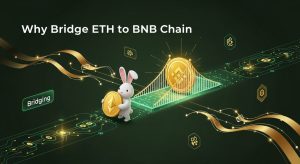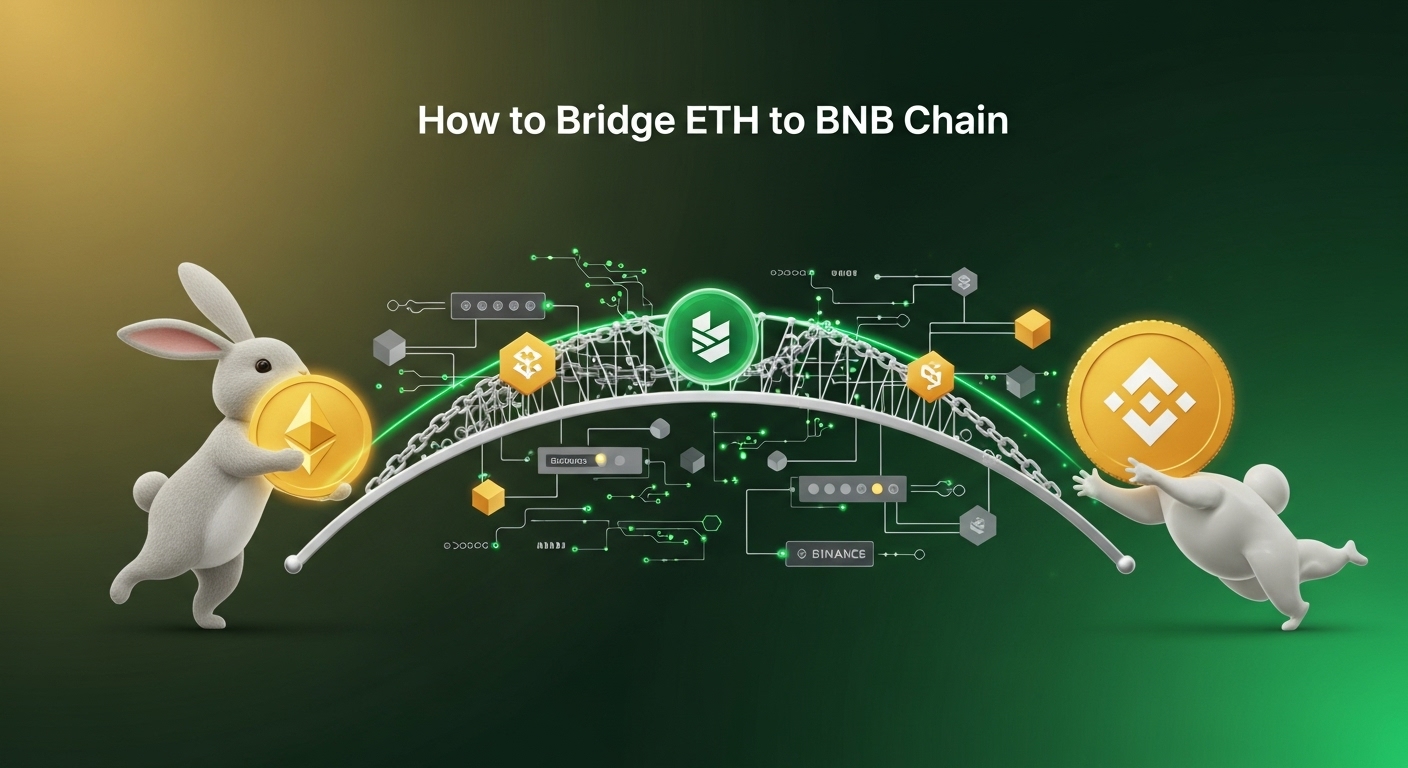Moving your Ethereum (ETH) assets to the BNB Chain lets you tap into lower fees and faster transactions. Bridging makes it possible to transfer tokens between these two popular networks securely.
This guide will show you why users bridge ETH to BNB, how to pick a trustworthy bridge, and walk you through a simple step-by-step process.
You’ll also find alternative ways to move your crypto and essential safety tips to protect your funds. Whether you’re new to bridging or want to avoid common pitfalls, this beginner-friendly walkthrough will get you covered.
Why Bridge ETH to BNB Chain

Moving Ethereum assets to BNB Chain opens up opportunities that go beyond just sending tokens from one wallet to another.
The two networks work differently when it comes to speed, fees, and available applications. Bridging your ETH to BNB Chain means you can take advantage of features that make your crypto experience smoother and often cheaper. Further your knowledge on how to bridge on Binance by checking this guide, Binance Bridge Guide.
Here’s why many users are making the switch or expanding to BNB Chain.
Lower Transaction Fees on BNB
One of the biggest reasons people bridge ETH to BNB Chain is cost savings. Ethereum’s network fees, known as gas fees, often spike during high traffic periods.
These fees can easily hit $20 to $50 or more for complex transactions like decentralized exchanges or NFTs. For someone experimenting with small trades or minting NFTs on a budget, this adds up quickly.
In contrast, BNB Chain offers much lower gas prices, generally costing just a few cents per transaction. This shift lets you trade more often or try out new DeFi tools without worrying about losing value to fees.
You can think of BNB Chain as a budget-friendly alternative that keeps your wallet happy while you stay active in crypto.
Faster Confirmation Times
Time matters in crypto transactions, especially for gaming, NFT releases, or any activity where waiting minutes feels like forever. Ethereum blocks are produced approximately every 13 seconds, but high network demand can push final confirmation times longer.
BNB Chain confirms blocks every 3 seconds or so, cutting waiting time dramatically. This means your transactions settle faster and you avoid slowdowns when the network fills up.
For projects where speed is key, like NFT drops or in-game actions, this faster finality smooths out the user experience and keeps momentum going.
Access to BNB DeFi Ecosystem
Bridging ETH assets to the BNB Chain is not just about saving money and time. It also unlocks access to an entire set of protocols and platforms built on BNB Chain.
Some of the popular ones include:
• PancakeSwap: The biggest decentralized exchange (DEX) on BNB Chain, offering token swaps, yield farming, and lotteries.
• Venus: A money market protocol allowing users to lend and borrow crypto with ease.
• GameFi Platforms: Various blockchain games and NFT marketplaces operate exclusively on BNB Chain, benefiting from its speed and lower cost.
Having ETH-derived assets on BNB lets you participate in these DeFi opportunities without needing to buy new tokens.
You get to use your existing ETH to explore swapping, lending, or gaming on BNB Chain, expanding your options at a lower cost and faster pace.
Bridging ETH to BNB Chain is a practical step for anyone wanting efficient transactions and broader access to growing decentralized finance and gaming projects.
The combination of lower fees, speed, and ecosystem reach brings clear benefits for every crypto user.
Choosing a Safe Bridge

Picking the right bridge to move your ETH to BNB Chain is key to protecting your funds and having a smooth experience. Not all bridges are built the same, and some can put your assets at risk.
Before you start transferring your tokens, it helps to know what to look for in a safe bridge. This includes understanding how to verify its security, the type of custody it offers, which tokens it supports, and how fees and speed compare.
Consider reading this article to explore various Bridges for BNB, Best BNB Bridges.
Here’s a clear breakdown to help you make a confident choice.
Security Audits and Reputation
A bridge’s security depends heavily on its code and operation being tested by experts. Security audits are thorough checks by third-party firms that hunt for vulnerabilities in a bridge’s smart contracts and backend.
When a bridge has multiple audits, especially from well-known firms, it signals a stronger commitment to safety.
You can find audit reports published on the bridge’s official site or repositories like GitHub. These reports highlight any past issues and show how they were fixed.
Alongside audits, community feedback is a great resource. User reviews on forums, social media, and crypto communities often reveal real-world experiences, highlighting potential scams or glitches.
Prioritize bridges that combine multiple audits with positive user feedback. Avoid services with little transparency or a history of hacks and unresolved problems.
Non-custodial vs Custodial Options
Bridges come in two main forms: custodial and non-custodial. The difference is simple but important for your control and security.
• Custodial Bridges: These hold your tokens on their own servers while the transfer happens. You trust the service to manage your assets during the bridge process. This can be faster but carries risk if their system is hacked or the team disappears.
• Non-custodial Bridges: These let you keep control of your private keys at all times. The bridge contracts handle token locking and releasing without ever taking possession of your funds. This reduces risk since you don’t depend on a middleman to guard your assets.
For most users, non-custodial bridges offer better security. You remain the true owner of your tokens throughout the process.
Supported Tokens and Liquidity
Not every bridge supports every type or version of ETH. Some use wrapped ETH (WETH) or specially bridged tokens that represent ETH on BNB Chain.
It’s crucial to confirm the bridge supports the exact token you want to transfer, whether that’s native ETH or a wrapped form.
Another key factor is liquidity. Bridges rely on pools of tokens to swap assets between networks. If the liquidity is low, your transfer can suffer slippage, meaning you might get fewer tokens on the BNB side than expected. Liquidity matters most when moving larger amounts; lower liquidity can cause unexpected losses.
Check a bridge’s documented token support and current liquidity levels before starting your transfer. This will protect you from unwanted surprises.
Fee Structure and Speed Comparison
Bridges vary in how much they charge fees and how quickly they complete transfers. It helps to compare these factors side by side when deciding on a bridge.
Lower fees are better, of course, but don’t sacrifice security for cost. Speed also varies depending on network congestion and the bridge’s mechanism.
A simple interface with clear instructions can save you time and frustration, especially if you’re new to bridging.
Keep these factors in mind to pick a bridge that matches your needs for cost, speed, and ease of use.
This guidance will help you sift through the many options and find a bridge that keeps your ETH safe while moving it over to BNB Chain. Next, we’ll look at how to complete your transfer step-by-step with popular bridges.
How to Bridge ETH to BNB
Bridging ETH to the BNB Chain may sound complex, but it’s actually straightforward once you follow the right steps. This guide will walk you through using a popular, trusted bridge to move your Ethereum assets safely and efficiently.
Each step keeps your funds secure and helps you avoid common mistakes. Let’s break down the process into clear parts so you can bridge your ETH to BNB Chain with confidence.
Prepare Your Wallets and Funds
Start by installing a Web3 wallet if you don’t already have one. MetaMask and Trust Wallet are the most popular and reliable options.
After setting up your wallet, make sure it’s funded with enough ETH to cover the gas fees on Ethereum. These fees can fluctuate, so check the current gas prices before moving ahead.
Next, add the BNB Chain network to your wallet if it’s not in your network list. This lets your wallet interact with the BNB Chain after bridging.
For MetaMask, you can do this by adding a new custom RPC with the appropriate BNB Chain settings. This step prevents confusion later and keeps everything connected smoothly.
Connect to the Bridge Website
Open the official URL of the bridge you’ve chosen. Double-check that the address starts with https:// and matches the correct domain to avoid phishing scams. Look for the “Connect Wallet” button, usually in the top right corner.
Click it and select your wallet provider, either MetaMask, Trust Wallet, or another that’s supported. Your wallet will likely ask for permission to connect. Accept this prompt so the website can interact with your wallet to start the token transfer process.
Select ETH as Source and BNB as Destination
Once connected, you will see options to pick the source and destination chains. Choose Ethereum (ETH) as the source chain where your tokens currently live. For the destination, select BNB Chain as the network where you want to receive your bridged assets.
Double-check the token symbols on both sides. It usually shows ETH on the source and often wrapped ETH or a pegged ETH token on the destination. Confirming this ensures you don’t accidentally send the wrong token or chain.
Review Transaction Details and Confirm
Before moving forward, review the transaction info carefully. This includes the amount of ETH you want to bridge, the estimated gas fees, and the expected arrival time on BNB Chain.
Bridges may display an estimated fee and wait time depending on network congestion.
If everything looks correct, click the confirm button in the bridge interface. It’s a good idea to take a screenshot or save the transaction details for your records. This helps with tracking and troubleshooting if anything unexpected happens.
Verify Receipt on BNB Chain
After confirming the bridge transaction, switch your wallet to the BNB Chain network to check your assets. Look for the wrapped ETH token or its equivalent in your wallet’s asset list.
To be extra sure, track the transaction hash using a BNB Chain explorer like BscScan. This shows the status and confirmation details on the blockchain, giving you peace of mind that your bridged tokens arrived safely.
Following these steps will take you through a secure and smooth process to bridge ETH to BNB Chain. Once your tokens are confirmed, you’re ready to explore the faster and cheaper opportunities waiting on BNB.
How to Bridge ETH to BNB
If you want a straightforward way to move your ETH to BNB Chain without using a bridge directly, Binance offers a reliable option.
Instead of relying on cross-chain protocols that lock and mint tokens, you can deposit your ETH to Binance, convert it to BNB if needed, and then withdraw it on the BNB Chain network.
This approach is familiar to many, especially if you already use Binance for trading or storing crypto. Let’s break down the process into clear steps.
Deposit ETH to Binance
Start by logging into your Binance account. Head to the Wallet section, then choose Fiat and Spot. Find Ethereum (ETH) from your asset list and click Deposit. Binance will generate a unique ETH deposit address for you.
Copy this address and send your ETH from your external wallet or exchange. Be sure to send native ETH, not tokens like WBTC or other Ethereum-based assets, unless confirmed supported. After sending, wait for the required network confirmations, usually 12 or more, to make sure the transaction is final.
This step can take anywhere from a few minutes to an hour, depending on the Ethereum network congestion. Once confirmed, your ETH will appear in your Binance wallet, ready for conversion or withdrawal.
Convert to BNB if Needed
With ETH in your Binance wallet, you can easily swap it for BNB. Go to Binance’s Trade section and choose the Spot Market. Search for the ETH/BNB trading pair.
You’ll see real-time prices and order options. If you want to get BNB, simply choose a market or limit order depending on your strategy, then confirm the trade. Alternatively, within your wallet dashboard, Binance often offers a Convert feature for simple, instant swaps without order books.
This conversion is optional if you want to keep your funds as ETH on BNB Chain, but swapping to BNB usually makes sense because native BNB transactions on BNB Chain have much lower fees and better ecosystem compatibility.
Withdraw to BNB Chain Address
Now, it’s time to withdraw your assets to your BNB Chain wallet. Under Fiat and Spot, select Withdraw. Choose BNB or ETH (if supported on BNB Chain) as the token to send out.
Most importantly, select BNB Chain (BEP20) as the withdrawal network. This choice ensures your transfer occurs on the BNB Chain network, not Ethereum or other chains. Paste your destination address carefully, the wallet address you control on BNB Chain.
Double-check the address and network selection before confirming. Binance will show the withdrawal fee, which is generally lower on BNB Chain due to the network’s efficiency. Confirm the transaction and wait for Binance to process it. Withdrawals usually happen within a few minutes.
Pros and Cons of the Exchange Route
This method can be very tempting, but it’s worth knowing the upsides and downsides.
Advantages:
• Speed: Deposit and withdrawal times are usually quick, depending on network status and Binance’s processing.
• Support: Binance customer service can help with issues, making it more reassuring for newcomers.
• Simplicity: No complicated bridging steps; you just trade and transfer inside one platform.
Disadvantages:
• KYC Requirements: Binance requires verification, which means you must provide your personal ID to use this option.
• Custodial Risk: Your funds are held by Binance during the process, so you must trust their security.
• Withdrawal Fees on Large Transfers: Sometimes fees or minimum withdrawal limits can be less flexible, especially if you want to move very large amounts.
If you want a safe and speedy method without managing multiple wallets or bridge protocols, Binance’s exchange route is a practical choice.
However, if preserving full control over your tokens is your priority, using direct bridges might be better.
For users interested in trading options and exchange reviews, check out our article on Best crypto exchanges for buying Bitcoin to see how Binance stands among other platforms. Also, if you want to prepare your wallets well before bridging, our Top Web3 wallets compared guide can help get you ready.
How to Bridge ETH to BNB
When bridging ETH to BNB Chain, handling your assets carefully is essential. Even though bridges simplify moving tokens between networks, mistakes or overlooking details can lead to loss or delays.
Taking certain precautions can protect your funds and give you confidence throughout the process. Here are some simple but important safety steps to keep in mind.
Test With a Small Amount First
It might be tempting to transfer a large sum of ETH right away, but starting small pays off. Sending a tiny amount first lets you confirm the bridge works as expected and your wallet settings are correct.
If anything goes wrong, losing a small amount is easier to recover from compared to a full transfer. This step also helps familiarize you with the timing and fees involved without risking much.
Think of it like dipping your toes in cold water before swimming. Once you see the test transaction succeed, you can move larger amounts safely.
Double-Check Contract Addresses and Network
Bridges require interaction with specific smart contracts on both Ethereum and BNB chains. Using the wrong contract address or network can cause transactions to fail or your funds to be lost.
Always verify the bridge’s contract address matches official sources, like their website or audit reports.
Also, confirm your wallet is connected to the correct network, whether Ethereum Mainnet or BNB Chain. Many wallets support switching networks, but a simple mistake here can result in tokens not showing up or transactions getting rejected. Being thorough now saves headaches later.
Keep Private Keys Secure
Your private keys control access to your crypto wallets. Sharing them or storing them insecurely risks complete loss of your funds. Never enter private keys into untrusted websites or share them with anyone claiming to assist you.
For larger transfers, consider using a hardware wallet. These devices store your keys offline, protecting you from online hacks and phishing attacks. When bridging ETH to BNB Chain, a hardware wallet adds a strong layer of security and peace of mind.
Monitor Bridge Status and Announcements
Crypto bridges occasionally undergo maintenance or face issues that affect transfers. Checking the bridge’s status page or official social media channels before and during your transaction helps you avoid surprises.
Maintenance pauses or detected vulnerabilities might delay your transfer or require action. Following updates from the bridge provider ensures you’re informed about any risks or outages. Staying alert means you can pause or adjust your bridging plan when needed.
Taking these risk management steps seriously helps protect your assets when moving ETH to BNB Chain. They reduce mistakes and guard against external threats, so your bridging experience stays smooth and secure.
For more detailed tips on keeping your crypto safe, you might want to explore guides on crypto wallet security and avoiding common scams.
Conclusion
Bridging ETH to BNB Chain unlocks faster transactions, lower fees, and access to an expanding DeFi and gaming ecosystem. Choosing the right bridge involves checking for strong security, supported tokens, fees, speed, and ease of use.
Whether you use a direct bridge or Binance’s exchange method, a clear step-by-step approach ensures a smooth transfer. Always test with a small amount first and keep your wallet secure to avoid costly mistakes.
Take the first step by trying a small transfer through a trusted bridge and share your experience in the comments below. Your feedback helps others bridge with confidence and makes the crypto community stronger.
For setting up your wallet before bridging, check out the best MetaMask alternatives that offer secure and user-friendly options.

Adeyemi Adetilewa is a digital marketing strategist and writer with over a decade of experience helping B2B, SaaS, Web3, and eCommerce brands grow through data-driven marketing. Adeyemi empowers professionals and business owners with actionable insights, growth strategies, and digital tools for success.

